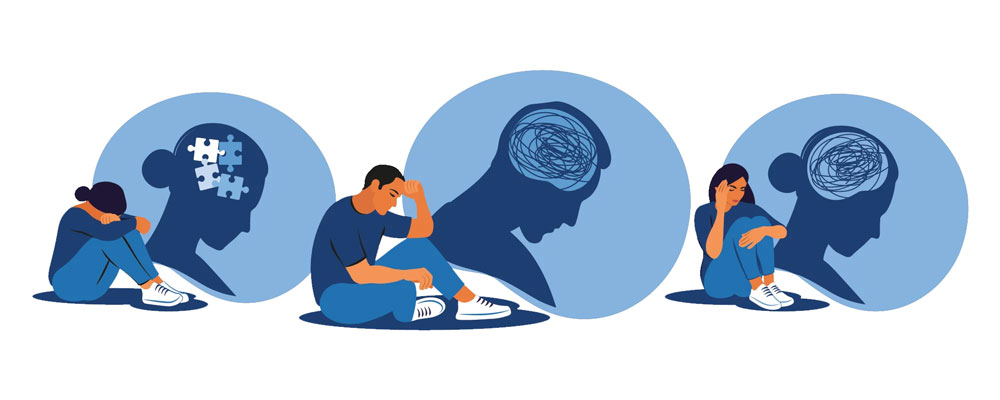Complete Guide to Mental Disorders

Increasing awareness about mental health is a crucial step in building a healthier and more empathetic society. Many of us struggle with emotional challenges or have loved ones dealing with these issues. The purpose of this article is to provide a general, simple, and understandable overview of some of the most common mental disorders. By categorizing similar disorders together, we aim to gain a better understanding of the complexities of the psychological world and to look at these issues with more thoughtful and precise insight.
Table of Contents
- 1. Mood Disorders: Severe Fluctuations in the World of Emotions
- 2. Anxiety and Obsessive-Compulsive Disorders: When Fear and Worry Dominate Life
- 3. Personality Disorders: Enduring Patterns of Thinking and Behavior
- 4. Dissociative, Psychotic, and Somatoform Disorders: Separation from Reality and the Mind-Body Connection
- 5. Other Important Disorders: From ADHD to Self-Harm
- Conclusion: A Step Toward Greater Understanding and Empathy
1. Mood Disorders: Severe Fluctuations in the World of Emotions
The main feature of mood disorders is dramatic and sometimes debilitating changes in emotional state, energy, and mood of individuals. These severe fluctuations, ranging from excessive joy and energy to deep sadness and indifference, can disrupt daily functioning, relationships, and overall quality of life.
1.1. Major Depressive Disorder (Major Depressive Disorder)
Major Depressive Disorder (MDD), often simply referred to as "depression," is a serious mood disorder characterized by a period of at least two weeks of depressed mood or loss of interest and pleasure in most activities. This persistent state of sadness and hopelessness goes beyond ordinary life's sorrows and is accompanied by symptoms such as changes in sleep and appetite, feelings of worthlessness and guilt, decreased energy, difficulty concentrating, and recurrent thoughts of death or suicide. This disorder impairs the individual's ability to function effectively in daily life.
1.2. Bipolar Disorder (Bipolar Disorder)
Individuals with bipolar disorder experience contrasting mood episodes. In one period called "mania," the person is extremely happy, energetic, has reduced need for sleep, and may exhibit risky and impulsive behaviors. In contrast, the "depressive" period is accompanied by deep sadness and sorrow, lack of motivation, and severe reduction in energy. These intense emotional changes may occur suddenly or gradually and completely affect the individual's life.
1.3. Cyclothymic Disorder (Cyclothymia)
Cyclothymic disorder can be considered a chronic and milder form of bipolar disorder. In this state, mood fluctuations also exist, and the individual experiences periods of high energy and hypomania (mild mania) and depressive periods, but the key difference is that the intensity of these changes never reaches the level of a full manic episode or a major depressive episode and has lasted for at least two years.
While mood disorders drag the vertical axis of our emotions from peak to trough, anxiety disorders trap us in a horizontal state of constant fear and worry. Let's see how this widespread distress manifests itself.

2. Anxiety and Obsessive-Compulsive Disorders: When Fear and Worry Dominate Life
Fear and anxiety are natural body responses to protect us from danger. But what happens when this natural warning system becomes disordered? This section delves into the world of anxiety and obsessive-compulsive disorders, where fear and worry become constant and unwanted companions, reducing quality of life by creating irrational fears and avoidance behaviors.
2.1. Obsessive-Compulsive Disorder (Obsessive-Compulsive Disorder - OCD)
In Obsessive-Compulsive Disorder (OCD), the individual faces two main challenges: "obsessions" which are unwanted, unpleasant, and repetitive thoughts that cause severe anxiety, and "compulsions" which are repetitive behaviors or mental acts that the person performs to reduce the anxiety caused by those thoughts. As a concrete example, someone who constantly thinks their hands are contaminated (obsession) may wash their hands hundreds of times a day to escape this thought (compulsion), and this time-consuming and distressing cycle disrupts their daily functioning.
2.2. Post-Traumatic Stress Disorder (Post-Traumatic Stress Disorder - PTSD)
Post-Traumatic Stress Disorder (PTSD) occurs following the experience or witnessing of a terrifying or life-threatening event such as war, natural disasters, severe accidents, or assault. The affected individual constantly recalls memories of that event in their mind, which appear as nightmares or flashbacks. These painful recollections lead to states of severe anxiety and stress, avoidance of anything reminiscent of the trauma, and excessive arousal (such as constant vigilance).
2.3. Social Anxiety Disorder (Social Anxiety Disorder)
The primary fear in social anxiety disorder is being judged or embarrassed in performance or social situations. These individuals are constantly worried that others will negatively evaluate them, mock them, or do something that causes them shame. This intense fear can include interacting with others, speaking in public, eating or drinking in public, and even using public restrooms. The consequence of this deep fear is avoiding large gatherings and social situations, which can lead to severe isolation.
2.4. Specific Phobias (Specific Phobias)
Phobia refers to intense, irrational, and persistent fears of a specific situation or object that pose no real danger or whose danger is not proportionate to the intensity of the reaction. Common examples include fear of heights (acrophobia), insects (entomophobia), or enclosed spaces (claustrophobia). The intensity of these fears is such that it limits the individual's life and compels them to avoid confronting that situation or object at any cost, even if this avoidance entails heavy costs.
2.5. Panic Disorder (Panic Disorder)
The main feature of panic disorder is experiencing sudden and intense fear attacks known as "panic attacks." These attacks, which sometimes occur without any apparent reason (unexpected) or in response to a specific situation (situational), are accompanied by severe physical symptoms: heart palpitations, sweating, trembling, shortness of breath, chest pain, dizziness, and fear of losing control or dying. The affected individual is often constantly worried about future attacks after experiencing them.
2.6. Separation Anxiety Disorder (Separation Anxiety Disorder)
This disorder is more common in children, and its main characteristic is intense and developmentally inappropriate fear and worry when separating from parents or the primary caregiver. The individual (child or adult) is extremely worried about being harmed or losing their primary attachment and resists separation from them or home. However, it should be noted that adults may also experience this type of anxiety in close relationships, experiencing separation with severe and intolerable distress.
Moving beyond the world of anxiety, we now turn to more complex and enduring patterns that shape the fabric of an individual's personality and identity.
3. Personality Disorders: Enduring Patterns of Thinking and Behavior
Personality disorders are deep, enduring, and inflexible patterns of thinking, feeling, and behavior that begin in adolescence or early adulthood. These ingrained patterns not only differ from cultural norms and are pervasive across most situations but also profoundly affect the individual's sense of "self" and their place in the world, causing serious problems in interpersonal relationships, social and occupational functioning. These disorders are typically divided into three clusters: A (odd and eccentric), B (dramatic and emotional), and C (anxious and fearful).
3.1. Borderline Personality Disorder (Borderline Personality Disorder - BPD)
The main feature of borderline personality is pervasive instability in interpersonal relationships, self-image, affects, and marked impulsivity. The individual may feel intense love (idealization) toward someone one moment and hate the same person the next (devaluation). These intense emotional fluctuations, along with frantic efforts to avoid abandonment, self-harm or recurrent suicidal behavior, and chronic feelings of emptiness, make finding a stable ground for others and oneself very difficult, leading to relationships characterized by passionate but short-term connections, mistrust, and frequent conflicts.
3.2. Antisocial Personality Disorder (Antisocial Personality Disorder - ASPD)
Individuals with antisocial personality disorder have no respect for laws and others' rights and exhibit a pervasive pattern of disregard for and violation of others' rights beginning at age 15. They may engage in dangerous and reckless behaviors, lying and deceit are the main features of their interactions, and they lack empathy or remorse (guilt) for their actions. This disorder is often associated with concepts such as sociopathy or psychopathy, and in pursuing their goals, they disregard others' well-being.
3.3. Histrionic Personality Disorder (Histrionic Personality Disorder - HPD)
Severe need for attention is the key feature of histrionic personality. These individuals, through dramatic, emotional, and exaggerated behaviors, using physical appearance to attract attention, and theatrical emotional expression, strive to always be the center of attention. Their speech style is often vague and lacking in detail. If this need is not met, they become extremely upset and distressed and may quickly change emotional dimensions to regain focus on themselves.
3.4. Obsessive-Compulsive Personality Disorder (Obsessive-Compulsive Personality Disorder - OCPD)
Although the name of this disorder is similar to Obsessive-Compulsive Disorder (OCD), it differs; in OCPD, unlike OCD, the individual does not feel distress and compulsion (ego-dystonic) in performing their behaviors but considers their behavior correct and useful (ego-syntonic). In this disorder, the focus is on excessive orderliness, perfectionism, need for interpersonal control, and rigid rules. This perfectionism hinders task completion, and the individual devotes excessive time to work and productivity. The fear of making mistakes becomes so paralyzing that the person gets lost in small details and fails to complete larger tasks.
3.5. Paranoid Personality Disorder (Paranoid Personality Disorder - PPD)
Constant and pervasive distrust and suspicion of others is the main hallmark of paranoid personality. These individuals always think that others intend to harm, exploit, deceive, or humiliate them, even if there is insufficient evidence to prove it. They interpret others' benign intentions as malicious conspiracies and are reluctant to confide personal information. This mindset keeps them in a constant state of defense and readiness, making it difficult to maintain close relationships.
3.6. Avoidant Personality Disorder (Avoidant Personality Disorder - AvPD)
Individuals with avoidant personality avoid social situations and relationships due to intense fear of judgment, rejection, and criticism, and are only willing to connect if they are certain of being accepted. The root of this behavior is feelings of inadequacy, shame, and profound lack of self-confidence, leading to social isolation and loneliness. Despite desiring closeness and intimacy, due to fear of vulnerability and negative evaluation, they actively avoid it.
Understanding these complex personality patterns prepares us to enter a category of disorders where the boundaries between self, reality, and even body fade.

4. Dissociative, Psychotic, and Somatoform Disorders: Separation from Reality and the Mind-Body Connection
In this category of disorders, the individual experiences a kind of "dissociation" or "separation" from reality, identity, memories, or even their own body. Psychotic disorders are characterized by disturbance in reality judgment (hallucinations and delusions), and dissociative disorders by deficits in integrated functions of consciousness and identity. Additionally, this section addresses the direct connection between mind and body and the impact of mental problems on physical health, showing how the human mind, to cope with severe stress, can alter the individual's experience of self and the surrounding world.
4.1. Schizophrenia (Schizophrenia)
Schizophrenia is a complex and chronic mental disorder in which the individual loses the ability to distinguish reality (psychosis). Its symptoms include delusions (fixed false beliefs, such as conspiracy delusions), hallucinations (unreal sensory perceptions, such as hearing voices), disorganized thinking and speech, and negative symptoms (such as reduced emotional expression and lack of motivation). This disorder severely impairs the individual's occupational and social functioning, and patients require ongoing specialized treatments, especially pharmacotherapy and psychological support, to manage symptoms and improve quality of life.
4.2. Dissociative Identity Disorder (Dissociative Identity Disorder - DID)
In this rare and complex disorder, often created in response to severe and repeated psychological traumas in childhood, the individual has two or more distinct identities or personality states, each with their own relatively enduring pattern of perception, relationship, and thinking about the environment and self. These identities alternately take control of the individual's behavior and usually lead to amnesia for important aspects of life and personal memories that the individual cannot recall.
4.3. Depersonalization/Derealization Disorder (Depersonalization/Derealization Disorder)
In this disorder, the individual feels detached from their body and thoughts; a sensation often described as "looking at oneself from outside," feeling like a robot, or detached from mental processes (depersonalization). At the same time, they may feel that the surrounding world is unreal, foggy, or like a movie, and objects appear distorted (derealization). These states, which usually occur after experiencing a stressful event or severe emotional trauma, are distressing but the individual understands that these states are not real and reality judgment is preserved.
4.4. Somatoform Disorders (Psychosomatic Disorders)
The concept of psychosomatic (now known in new classifications as somatic symptom disorders) refers to the direct connection between mind and body. In this state, stress, emotional pressures, and affective distress manifest as completely real physical symptoms or severe concern about health. For example, the individual may suffer from debilitating headaches, chronic pains, or gastrointestinal problems that are medically real, but their root is not a physical illness, but unresolved emotional distress transferred to the body.
Now we turn to the final category, which includes important disorders with unique features.
5. Other Important Disorders: From ADHD to Self-Harm
In addition to the above categories, there are other important disorders that affect various aspects of the individual's functioning, from concentration and attention to body image and emotion regulation.
5.1. Attention-Deficit/Hyperactivity Disorder (Attention-Deficit/Hyperactivity Disorder - ADHD)
ADHD is a disorder that, although more commonly diagnosed in children and adolescents, can continue into adulthood. The main features of this disorder include two dimensions: inattention (such as inability to focus, forgetfulness, and carelessness in details) and hyperactivity/impulsivity (such as physical hyperactivity, inner restlessness, haste and impulsivity in tasks, and interrupting others). These symptoms must be present in more than one setting (such as home and school/work) and significantly affect the individual's functioning.
5.2. Body Dysmorphic Disorder (Body Dysmorphic Disorder - BDD)
In this disorder, the individual has extreme sensitivity and preoccupation with a supposed flaw or defect in their appearance that is either unnoticeable or merely slight. These mental perceptions continue even when there is no real flaw in the individual's appearance or others see it as normal, compelling the person to repetitive behaviors (such as mirror checking, excessive grooming, or comparing themselves to others). This mental preoccupation can severely affect daily life, social relationships, and occupational functioning, causing significant distress.
5.3. Nonsuicidal Self-Injury (Nonsuicidal Self-Injury - NSSI)
Self-harm means intentionally inflicting physical harm on oneself (such as cutting, burning, or hitting) to relieve psychological pain or intense negative emotions (such as anger, sadness, or feelings of emptiness) without conscious intent to commit suicide. This behavior is usually an ineffective method for managing emotional and affective crises. People who self-harm often suffer from other mental problems such as depression, anxiety, or borderline personality disorder and need specialized help to learn more adaptive methods for emotion regulation.
✅ By participating in psychology educational courses, you will learn to better understand your mind and emotions and shape your relationships and life decisions with greater awareness. These courses are an opportunity for personal growth, mental peace, and deeper insight into the inner world.
- View the list of Psychology Education courses
Conclusion: A Step Toward Greater Understanding and Empathy
This article provided a brief look at the complex and diverse world of mental disorders. Understanding these concepts is not for labeling individuals, but for giving voice to their inner sufferings and experiences. This knowledge is the first step toward finding the right path to recovery, fostering compassion, and recognizing shared human vulnerability that connects us all. With better understanding of these issues, we can create a safer and more supportive space for discussing mental health and know that professional help is available.
We hope this information has been useful to you. Enhancing public awareness about mental health is a shared responsibility to build an accepting and supportive society.
Please Log in to leave a comment.